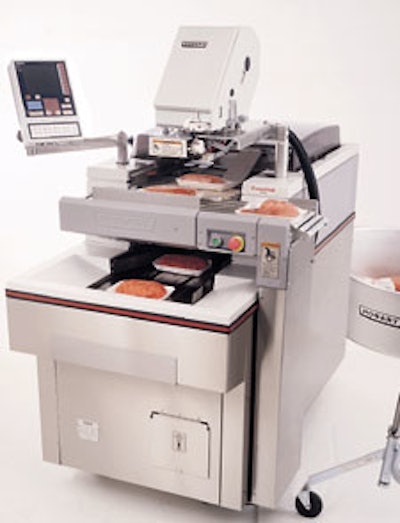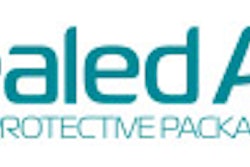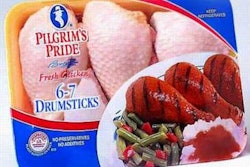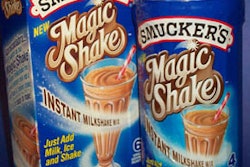
Meat and poultry packagers aren’t calling the U.S. Department of Agriculture equipment certification proposal a lot of baloney, but neither are they ready to exult “Hot dog!” either.
The proposal would set up a voluntary program whereby processing equipment—including packaging machines and packaging systems—would be certified as to its “sanitary” properties. The idea is to ensure that the equipment can be easily cleaned after use, to reduce the risk that meat and poultry could pick up bacteria from coming into contact with the machines. The current plan, based on the proposed rule issued in June, is for USDA employees to certify equipment using the NSF/3A 14159-1.
If it becomes final, the standard will be easy for some packaging systems to meet, and more difficult for others. For example, Richard Pittenger, agency approval engineer for Hobart Corp. (Troy, OH), says the standard requires a piece of equipment to be cleanable by a high-pressure, hot-water technique.
Hobart makes packaging equipment used in supermarket backrooms to wrap individual cuts of meat for retail display. Theoretically, the meat product does not touch the packaging equipment because the cuts are usually loaded into a paper or plastic tray before being placed on the machine. Thus, in a technical sense, the machine may not even come under the new voluntary USDA program. Still, says Pittenger, supermarkets demand that the equipment meet “cleanability” guidelines. In the past, Hobart’s equipment met USDA standards.
But those standards did not have the “high-pressure” washdown requirement. Hobart’s equipment “is not [designed] for hose-down of any type,” says Pittenger. So the market for that Hobart equipment may dry up faster than a puddle in a desert.
Stainless endorsed
The standard also says that product contact surfaces can only be made out of five materials, all of which are some version of stainless steel. So aluminum is out. That is going to be a major problem for numerous food equipment manufacturers who have made their slicing, dicing and packaging machines out of aluminum because of its lighter weight, according to Geoffrey Rapp, vice president of engineering and quality for Bettcher Industries (Vermilion, OH).
But Rapp also noted there may be an upside to the program, which will allow processors to prove they have an effective HACCP (Hazard Analysis Critical Control Point) program. Moreover, the processor may reduce his equipment disassembly and scrubbing costs by using an easy-to-clean piece of equipment. Rapp thinks that when the costs of certification to the manufacturer—which will be passed on, have no doubt about that—are weighed against the likely benefits to the processor, it will be, no pun intended, a “wash.”
The NSF and 3A are both nonprofit U.S. standards development and certification organizations. The 3A was involved in writing the milk processing sanitation standard that FDA uses. The International Standards Organization (ISO) is in the process of adopting 14159—which has been adopted as a U.S. standard—as a general equipment sanitation standard.
Fred Hayes, a consultant to the Packaging Machinery Manufacturers Institute (PMMI), says it could take until 2002 for the ISO to make that standard final.
Meat-specific changes
The NSF and 3A took 14159, added some meat and poultry specific specifications, and called the standard 14159-1. It is not a U.S. standard at the moment but is currently under ballot by a joint committee of the NSF and 3A.
In its June proposed rule, FDA said it would charge manufacturers user fees to pay for the certification program. Again, this would be a voluntary program. But as is often the case when a federal agency offers a voluntary program, the potential beneficiaries interpret it as mandatory, in part because smart purchasers demand that equipment they buy be certified.
Packaging machinery purchasers have many questions about the new standard: If some of the equipment they use flunks a 14159-1 test, will that expose them to liability should there be a product contamination problem? Or will manufacturers have to increase the cost of the equipment to meet 14159-1 standards?
First, USDA estimates that it will cost a manufacturer $1겨 to have the certification done at its plant, plus the travel expenses for the person or persons doing the certification. So the total bill could well exceed $2ꯠ per visit. That may not be too big a hit for a manufacturer making a $250ꯠ machine that is sold, as is, to numerous customers.
Custom machinery, too?
But Hayes explains that it is not unusual for a machinery manufacturer to make custom versions of one machine for a number of customers. For example, the manufacturer may make a sausage tray loader whose packaging line handles 60 sausages/min for one processor, and another running 600 sausages/min for a second packager. The way the proposed rule is written, says Hayes, the manufacturer would require a separate certification for each custom version of the machine.
A second cost question is whether the equipment manufacturers would have to add bells and whistles to their current machines to meet 14159-1, thereby increasing the cost of the equipment to purchasers. Take a company like Cryovac Div., Sealed Air Corp. (Duncan, SC). It has a packaging materials/equipment division. Products include packaging systems like rotary vacuum chamber machines (that Cryovac does not make) that remove air and seal barrier bags of meat cuts. The system might include conveyors, in-feeders and bag loaders, all of which Cryovac does make. Again, to the extent that any of those system components come in contact with meat or poultry, they would be eligible for voluntary (often spelled m-a-n-d-a-t-o-r-y) certification.
Charles Barmore, a research fellow at Cryovac, says his company is still looking at the USDA proposal and has no comment prior to filing formal comments.
Some specifics cited
Todd McAloon, an official at Cargill (Minneapolis, MN), attended a public meeting USDA held in 1999. At the time, he said, “There is a lot of equipment out there now that isn’t cleanable, and a better standard is needed. If it costs more for a particular piece of equipment and that’s what we need for a sanitary design, then we will pay for it, and we will need to.” McAloon failed to return phone calls asking for comments on the June 2000 proposed rule.
Tom Gilmore, an official with the International Assn. of Food Industry Suppliers who worked on 14159-1, acknowledges that it does specify minimum finishes (how rough a surface can be) and minimum machine radiuses. In the case of the former, the standard includes an R(a) value for surface textures, including glass-beaded or shot-peened surfaces, 2B mill-finished surfaces, coatings and machined plastics. Then there is the requirement that a surface be made out of steel. Another material that cannot be used is bronze. It is frequently found in the form of bearings in the shafts of mixers.
Of course the driving force behind the USDA proposal is the recent spate of food recalls for hot dogs, hamburgers and other USDA-regulated products over the past year. President Clinton opened a major campaign against listeria in 1999 and contemplated all sorts of remedial measures.
Former program dropped
Until August ’97, USDA did have a “prior approval” equipment program in place. A manufacturer had to get prior approval before selling a new piece of equipment. But USDA ditched that program in the name of regulatory reform, which gave birth to HAACP. Normally, when a federal department or agency deep-sixes a regulatory program, jubilation breaks out among the regulated.
Not so in this case. Many manufacturers who were trying to sell high-quality machines found themselves undercut by manufacturers who cut corners to save money. In 1998, Congress told USDA to come up with a user-fee-funded, voluntary equipment certification program. The agency put out an early proposal in 1999 and a revised version in June of this year.
Meanwhile, there has been some concern among packaging equipment users that the “cleanability” of meat and poultry processing equipment has suffered.
Packagers cannot afford to leave even the smallest door open to meat contamination. In January 1999, Kraft Foods’ Oscar Mayer Div., Madison,WI, recalled over 28ꯠ lb of deli meat that could have been contaminated by Listeria monocytogenes bacteria, which can cause high fever, severe headache, neck stiffness and nausea. Claire Regan, spokeswoman for Oscar Mayer, says her division shares principles of sanitary design with its equipment suppliers. Kraft is supportive of the proposed USDA certification program and will sign on to any comments submitted by the American Meat Institute.
Although USDA annointed the NSF/3A standard, it still has a long way to go before being set in concrete. First, the ISO has already discarded the version of the base food equipment sanitary standard—14159—that is the basis for 14159-1 currently undergoing voting by the NSF/3A and scheduled to be considered by the American National Standards Institute (ANSI).
And even the latest version of 14159 that the ISO is considering is problematic, according to Hayes, the PMMI consultant. For example, it makes references to equipment “safety.” Hayes says, “Those references should come out.” The latest draft of 14159 also contains references to European standards dealing with warning labels and electric characteristics of machines. Those are not harmonized with U.S. standards on those subjects, Hayes points out.
So there appears to be more work to be done.






















